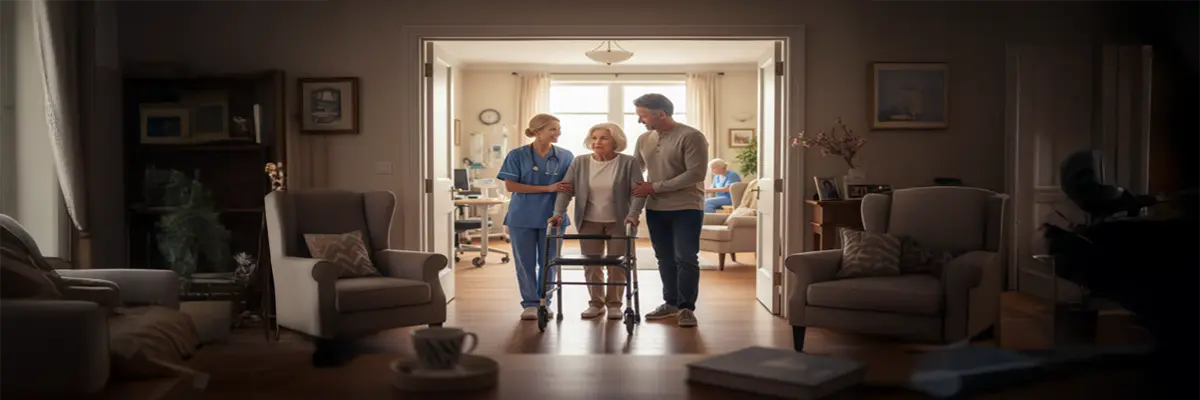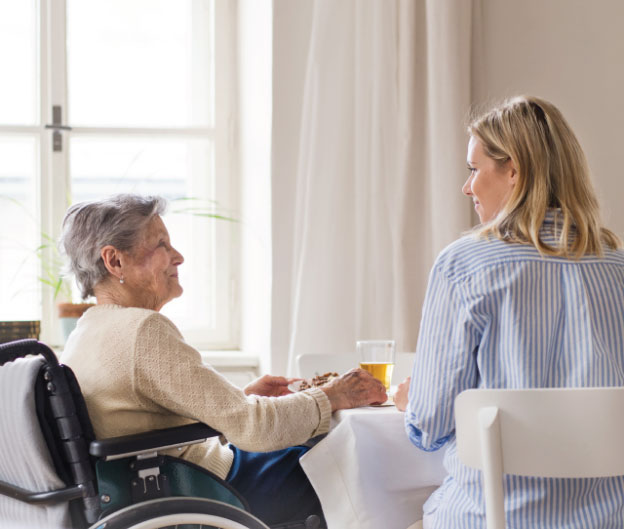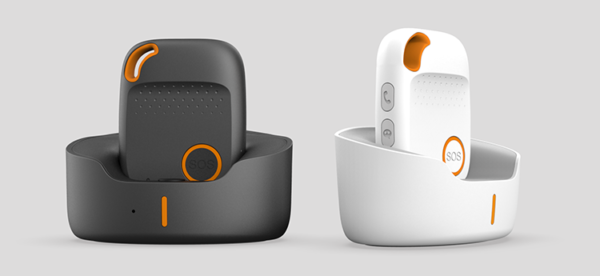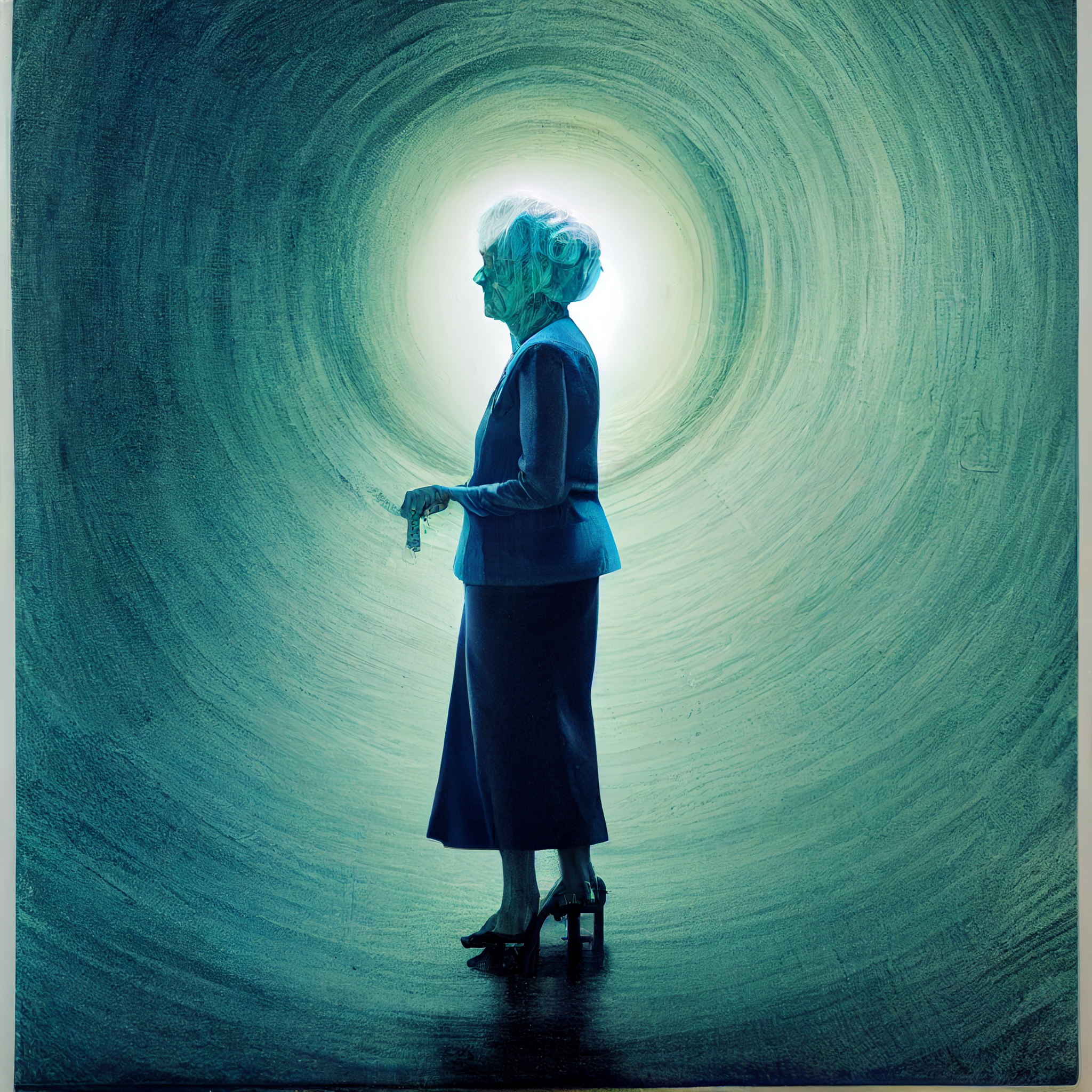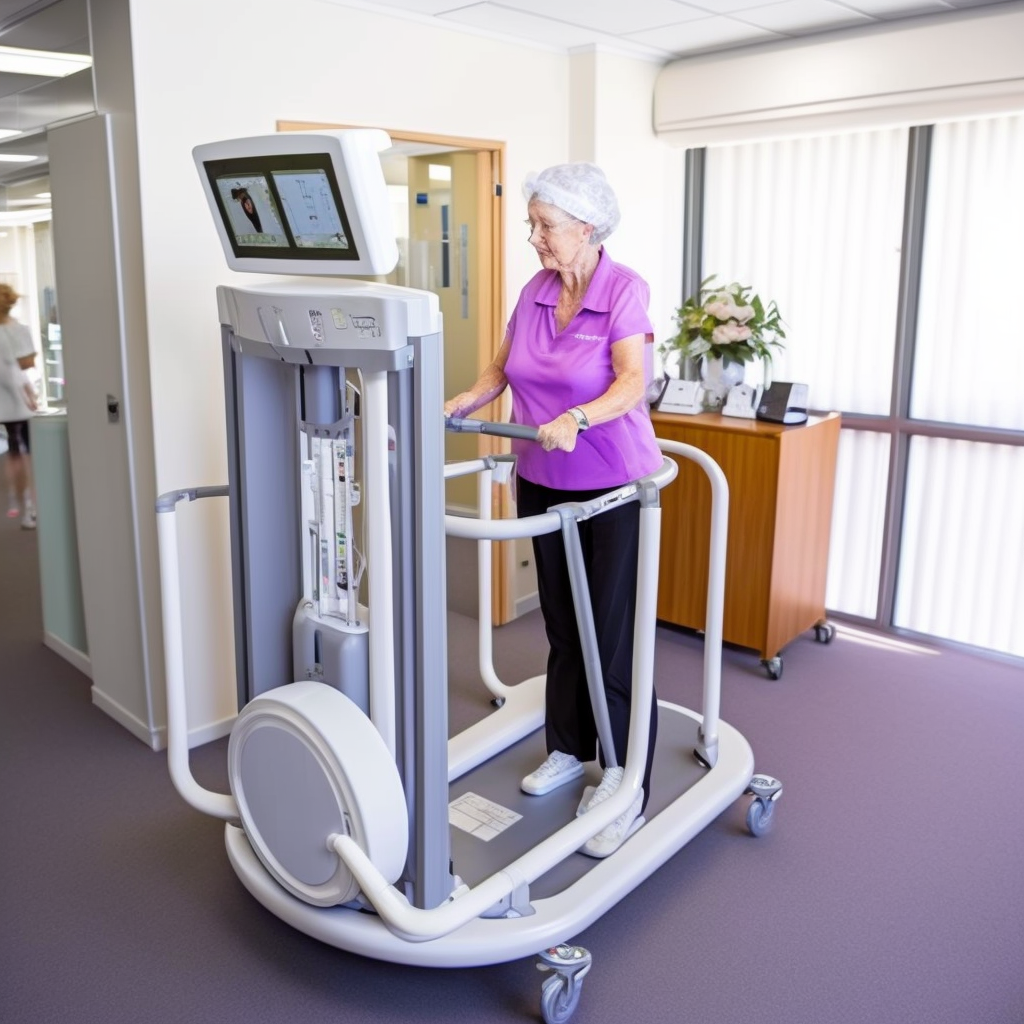How to Prevent Post-Discharge Falls in Hospitals: A Practical Guide for Healthcare Staff
Quick reality check: 40% of older people fall within 6 months of leaving hospital[2]. That’s not just a statistic – it’s a red flag signalling the most dangerous period in their recovery journey.
The numbers get worse. 10–15% need readmission after falling at home[2], 25% sustain injuries including fractures[2], and fall rates double compared to non-hospitalised populations[2] during that critical first month post-discharge.
Falls are now the No. 3 cause of hospital readmissions[3]. For patients initially admitted with fall-related injuries, they become the leading readmission diagnosis. We’re seeing a revolving door effect that compromises recovery, drains resources, and—most importantly—puts vulnerable patients at serious risk.
This guide cuts through the complexity. You’ll get evidence-backed strategies from the Australian Falls Guidelines 2025 to spot high-risk patients early, build targeted prevention plans, and coordinate the support that actually works. Whether you’re managing discharge planning, coordinating with families, or tracking readmission patterns, these tools can break the post-discharge fall cycle.
The challenge is real, but so are the solutions. Time to turn knowledge into action.
The Post-Discharge Danger Zone
Hospital-to-home transitions create a perfect storm. Patients lose strength and mobility during their stay, then face medication changes, reduced supervision, and unfamiliar home environments all at once.
Why Falls Spike After Discharge
Functional dependency drives the highest risk. Patients needing professional help post-discharge face a fall rate of 20.2% versus just 8.4% for independent patients [13]. Add cognitive impairment, assistive devices, and declining mobility—the risk compounds [13].
The shift from monitored hospital care to home supervision creates dangerous gaps. Post-discharge confusion affects many patients, substantially raising fall risk [13]. Medication adjustments, environmental changes, and reduced oversight turn the first weeks at home into a high-stakes transition.
Fall Risk Timeline: When Danger Peaks
| Timing Pattern | Fall Rate | Risk Context |
| First 2 weeks | 63% of all post-discharge falls [2] | Most dangerous period |
| First month | 2× higher than non-hospitalised populations [4] | Critical window |
| 6 months total | 40% of older people fall [2] | vs 30% annual community rate [4] |
Cumulative risk climbs steadily:
- 4.45% at 1 month
- 9.03% at 6 months
- 10.80% at 12 months [4]
Patients with depression, frailty, or limited mobility face significantly higher rates than those without these conditions [4].
The Readmission Reality
50% of post-discharge fallers sustain injuries [2]. Worse still, 10–15% need hospital readmission [2].
Fall-related injuries now rank as the No. 3 cause of readmissions, accounting for 5.1% of all readmission diagnoses [4]. For patients initially admitted with fall injuries, falls become the leading readmission diagnosis [4].
Financial impact: Hong Kong spends HKD176 million annually (≈USD28.9 million) on post-hospital fall care [3]. With readmission penalties mounting across healthcare systems, prevention becomes both clinical and economic imperative.
Quality of life costs: Functional decline, lost independence, fear of falling. Among those 75+, falls cause nearly 70% of accidental deaths [3].
The opportunity: Research shows cutting fall-related readmissions by just 20% could prevent ≈12,000 of 60,000 annual readmissions [4]. The tools exist—now it’s about implementation.
Spot High-Risk Patients Early
Catching vulnerable patients before discharge makes the difference between safe recovery and rapid readmission. Get the screening right, and you interrupt the fall-injury-readmission cycle at its weakest point.
Pick the Right Assessment Tools
No single tool fits every context, but pairing two complementary assessments improves accuracy [2]. Clinical judgement trumps scores—trust your instincts even when numbers look low [3].
Top Assessment Tools by Setting
| Tool | Best For | Key Advantage |
| STRATIFY | ICU settings | No direct observation needed [2] |
| Hendrich II (HIIFRM) | Acute care | Factors in high-risk medications [2] |
| Morse Fall Scale | Multi-department use | Quick assessment across units [2] |
| Timed Up-and-Go | Mobility screening | Functional measurement clinicians can do anywhere [2] |
Assessment timing checklist:
- At admission
- Daily as condition changes
- Before department transfers
- After any fall incident [3]
Flag Frailty and Depression Early
These two often-missed factors create a dangerous combination. Frailty mediates 18.9% of falls in depressed older adults, and 21.3% of multiple falls [3].
Depression hits 10–15% of community-dwelling seniors [11] and quadruples fall risk compared to non-depressed patients [12]. The cycle feeds itself: depression → falls → fear of falling → more depression [12].
Frailty warning signs:
- Strength ↓, energy ↓
- Gait speed slowing
- Unintentional weight loss
- Muscle mass reduction
Critical insight: 40.4% of depressed geriatric patients qualify as pre-frail or frail [12]—making this combo particularly lethal.
Apply Australian Falls Guidelines 2025
The first major revision since 2009 shifts focus from risk scoring to intervention implementation [13]. Key changes for hospital staff:
- Screen all adults during admission and discharge [2]
- Run detailed assessments for high-risk cases [2]
- Refer complex patients to specialists early [2]
- Don’t ignore middle-aged patients (45–64)—they’re as vulnerable as seniors [2]
Pre-discharge referral targets:
- OT assessment for home environment setup
- Physio consult to train caregivers on mobility support [3]
The guidelines emphasise person-centred plans over cookie-cutter approaches [13]. Fall risk varies massively between individuals—even those with identical diagnoses or ages.
Spot the patterns, use validated tools, and trust clinical judgement to identify the patients who need extra protection during that dangerous transition home.
Building Person-Centred Fall Prevention Plans
Spotting high-risk patients is just step one. The real work starts with creating targeted plans that address individual risk factors rather than generic tick-box approaches. According to the World Falls Guidelines, effective fall prevention demands person-centred planning that recognises each patient’s unique profile [4].
Matching Plans to Mobility & Cognitive Status
Not all patients face the same risks. Assessment results should drive intervention choice—patients with gait problems need balance-focused exercises, while those with cognitive impairment require completely different strategies [4].
Cognitive impairment adds layers of complexity. Pain, medication effects, and confusion significantly impact older patients’ ability to engage with prevention programmes [2]. Smart planning accounts for these realities:
Timing matters: Schedule interventions when patients are most alert
Communication style: Adjust language and methods based on cognitive status
Physical modifications: Scale interventions to actual mobility levels
Medication awareness: Factor in drugs affecting balance and cognition
For complex cases, multifactorial interventions—combinations of targeted strategies—prove most effective in community-dwelling older adults [4]. Multiple risk factors demand multiple solutions.
Goal-Setting That Actually Works
Patients and families must be active partners, not passive recipients. Research shows their involvement significantly reduces falls, particularly for moderate-risk patients [3].
Here’s the catch: many older people find goal-setting unfamiliar and complex [2]. Hospital staff need a different approach:
| Action | Why It Matters |
| One-to-one guidance sessions | Personal attention builds understanding |
| Skip jargon like “goal setting” | Use plain language patients recognise |
| Set realistic expectations | Unrealistic targets lead to abandonment |
| Build confidence first | Motivated patients stick with plans |
Timing is everything. Start goal discussions early in the hospital stay—not 10 minutes before discharge [2]. Revisit and refine goals before patients head home to ensure relevance for their actual living situation.
Fall Prevention Agreements between nursing teams and patients create tangible accountability. These use validated tools like the Morse Fall Scoring system to communicate risk and outline specific strategies [3]. Think of them as prevention contracts both sides commit to.
Documentation That Prevents Confusion
Clear documentation prevents good plans from failing at handover. Write fall prevention plans at fifth-grade reading level to ensure accessibility across literacy levels [3].
Essential documentation components:
- Specific risk factors identified during assessment
- Tailored interventions addressing each factor
- Implementation details for each intervention
- Monitoring approaches and effectiveness measures
- Revision notes based on changing circumstances
Digital Patient Rounding tools help nursing and allied health teams conduct structured checks with prompts covering mobility status and cognitive changes [11]. But technology only works if everyone uses it.
Communication rule: Document prevention plans on all handover sheets—nursing, medical, allied health, transfer, and discharge paperwork [12]. Siloed information kills continuity [12].
Bottom line: Risk scores mean nothing without targeted action [11]. Person-centred planning, collaborative goal-setting, and consistent documentation turn assessment data into actual fall prevention.
Patient Education: Making Prevention Stick
Education failures kill prevention plans. Even perfectly designed interventions collapse without communication that actually works—accommodating different learning styles, health literacy gaps, and the chaos of hospital discharge timing.
Teach-Back + Motivational Interviewing = Behaviour Change
Teach-back method flips traditional education on its head. Instead of lecturing, you ask patients to explain back what they’ve understood in their own words. This catches misunderstandings immediately and improves knowledge uptake whilst changing behaviours [13].
Quick implementation checklist: • Ask open-ended questions: “What would you do if you feel dizzy while walking?” • Correct gently: “Let’s strengthen that memory again…” • Keep repeating until they demonstrate clear understanding • Layer in multimedia resources for reinforcement
Results speak: teach-back cuts readmissions by 13% amongst cardiac patients [14] and significantly boosts satisfaction with medication education [14].
Motivational interviewing pairs perfectly with teach-back by tackling resistance to change. This patient-centred approach uses open questioning, affirmations, and reflections to create safe spaces where patients voice concerns they’d otherwise hide [15][15].
Education Format Decision Matrix
| Format | Best For | Evidence |
| Video demos | Visual learners, technique demonstration | Helps elderly patients visualise fall risks in realistic scenarios [17] |
| Print materials | Repeat reference, varied literacy levels | Booklets with clear illustrations facilitate better health literacy outcomes [5] |
| Face-to-face | Complex cases, relationship building | Patients prefer “conversation, not lecture” approach [2] |
| Multimedia combo | Maximum retention | Synergistic effect substantially increases effectiveness [18] |
Health Literacy Reality Check
60% of Australians have inadequate health literacy levels—only 6% demonstrate high health literacy [19]. For older Australians, these numbers drop further, creating a dangerous mismatch between fall risk and information accessibility [19].
Low health literacy barriers:
- Difficulty understanding educational materials
- Reduced engagement with interventions
- Challenges using monitoring technology
- Limited knowledge-to-action translation [5]
Evidence-backed solutions: ✓ Assess literacy levels before discharge, tailor accordingly ✓ Use culturally adapted, interactive communication approaches [20] ✓ Deliver education early in hospital stay—not during discharge chaos [2] ✓ Write discharge instructions at fifth-grade reading level
Bottom line: patients told us directly—”It shouldn’t be a lecture, but a conversation” [2]. Make it one.
Safe Home Environments: Your Discharge Safety Net
Home-based falls account for over 70,000 hospitalisations annually in Australia. Yet home modifications cut fall incidence by 21% among community-dwelling older people—making this your most cost-effective prevention strategy.
Home Safety Assessment Essentials
Professional home assessments work. The Westmead Home Safety Assessment delivers 0.80 content validity with reliable hazard identification across multiple assessors. Standard assessment covers eight critical zones:
| Assessment Area | Key Hazards | Quick Fixes |
| External/internal walkways | Uneven surfaces, poor lighting | Motion-sensor lights, non-slip strips |
| Bathroom & toilet | Wet floors, no grab supports | Install grab bars, rubber mats |
| Bedroom setup | Low beds, cluttered paths | Raise bed height, clear walkways |
| Lighting conditions | Inadequate illumination, shadows | LED bulbs, eliminate dark zones |
| Kitchen organisation | High shelves, cord hazards | Move essentials to waist height |
| Footwear | Loose slippers, smooth soles | Non-slip soles, secure fitting |
| Medication systems | Multiple bottles, poor labelling | Weekly pill organisers, clear labels |
| Emergency response | No alert systems | Personal alarms, emergency contacts |
OT Partnership: Beyond Basic Checklists
Occupational therapists spot what others miss. Environmental interventions prove particularly effective for individuals with fall histories—making OT referrals essential for repeat fallers approaching discharge.
Core OT contributions:
- Hazard identification using validated tools
- Equipment recommendations matched to functional capacity
- Activity modification strategies that maintain independence
- Follow-up assessments to adjust interventions
Embed OT home assessments into discharge planning for high-risk patients. Post-discharge OT visits catch emerging hazards that standard checklists miss.
Fall Safety Equipment: Evidence-Based Choices
Bed & Floor Monitoring Pressure-sensitive mats connect to alarm systems, enabling prompt caregiver response before falls occur. Integration with nurse-call systems provides 24/7 monitoring capability.
Fall-Absorbing Solutions
Foam or rubber crash mats cushion falls in high-risk areas. Available in alarmed or non-alarmed versions for different supervision levels.
Support & Stability
- Grab bars: Professional installation ensures proper placement and secure attachment
- Non-slip surfaces: From permanent flooring to temporary peel-and-stick solutions
- Low-lying beds: Electric adjustment reduces fall injury severity whilst allowing care access
Detection Technology Wearable fall detection devices automatically alert caregivers or emergency services—critical for patients living alone post-discharge.
Equipment Selection Protocol:
- Assess individual patient needs and home layout
- Match equipment capabilities to supervision availability
- Ensure professional installation where required
- Provide user training for patients and carers
Hospital assessment services can match appropriate equipment to individual requirements. One key supplier notes: “whether you are a hospital, small facility, or private home, we can match our equipment to meet your needs”.
Through systematic assessment, targeted modifications, and appropriate safety technology, home environment interventions substantially reduce post-discharge fall risk whilst promoting sustained independence.
Tech Solutions That Actually Work
Technology now delivers measurable protection for post-discharge patients. Falls ↓ 33.7% and fall-related injuries ↓ 47.4% when remote monitoring supports standard care. The savings? AUD 3.06 million annually across health systems.
Fall Alert Systems for Home Transition
Wearable fall detection creates an immediate safety net. These devices monitor movement patterns and automatically alert caregivers or emergency services when falls occur.
Safe-Life Australia offers proven options: • 4G medical alarms with SMS alerts—waterproof, lightweight, everyday wearable • Bed exit alarms and chair mat sensors that trigger before falls happen • GPS tracking for location monitoring beyond the home environment
The technology works through three core functions: movement sensors detect unusual patterns, automatic alert systems notify designated contacts, and GPS positioning tracks location for emergency response.
Remote Monitoring: Virtual Eyes on Vulnerable Patients
Portable video monitoring (PVM) systems detect patient movement and alert nurses through sound and visual cues on monitoring screens. One three-month hospital trial generated 1,654 nursing interventions based on these alerts—with staff strongly supporting continued use.
Virtual sitter technology draws invisible “bed rail zones” around patients. Cross the boundary, trigger the alarm. Results speak for themselves: one brain injury rehabilitation unit saw falls drop from 10.26 to 6.87 per 1,000 patient-days.
Data Collection That Drives Better Outcomes
Current post-fall monitoring achieves 86–99.62% accuracy rates. Modern systems integrate:
| System Component | Function | Benefit |
| Wearable sensors (lower back, trunk, waist) | Continuous movement monitoring | Real-time fall detection |
| IoT device networks | Connected monitoring ecosystem | Pattern identification across settings |
| Geospatial tracking | Emergency location services | Faster response times |
This data enables pattern recognition, intervention assessment, and targeted prevention strategies. Research confirms sensor-based fall risk assessment works even for patients with dementia—though accuracy varies by sensor placement and attachment methods.
Emerging tech includes exergames, VR balance training, and robotic walking aids. These approaches shift from reactive monitoring to proactive prevention.
Connecting Patients to Post-Discharge Support
The hospital-to-home handoff succeeds or fails based on what happens next. Effective coordination links patients with the right services at the right time—before problems escalate into readmissions.
Finding Local Fall Prevention Services
Start the search before discharge day. Most states maintain comprehensive service directories that map local options by region and specialty type.
South Australia: Falls Prevention Service Directory includes referral forms, decision tools, and clinic locations for at-risk older adults [30].
Local Health Networks: Many run specialised assessment clinics—Central Adelaide’s Community Falls Prevention Service and Northern Adelaide’s Specialist Ambulatory Rehabilitation Centre (SpARC) both accept professional referrals [30].
Council services: Check local government websites for community programs, often free or low-cost.
National gateway: My Aged Care remains Australia’s primary entry point for government-funded aged care services [30].
Commonwealth Home Support Programme (CHSP) Services
CHSP delivers practical fall prevention support where patients live:
- Home maintenance → removes trip hazards
- Safety aid installation → alarms, ramps, support rails
- Professional mobility support → tailored assistance [31]
Eligibility: 65+ years (50+ for Aboriginal and Torres Strait Islander people) [31]. Costs vary by income and service type.
Evidence base: Community programs like Stepping On cut fall risk by 30%+ through 7-week workshops combining strength training with behaviour change [32].
Scheduling Effective Follow-Up
Research shows structured follow-up significantly improves outcomes. Falls clinics typically offer:
Initial assessment: 2-hour comprehensive evaluation with nurses, physios, and dietitians developing tailored treatment plans [32].
GP communication: Written recommendations and treatment summaries sent to both patient and GP [32].
Home risk assessment: OT-led evaluations in the patient’s actual living environment, with modification recommendations [32].
Ongoing monitoring: Regular check-ins to track progress and adjust interventions.
Key message for patients: Discuss every fall with your GP—even minor ones without injury—to identify and address contributing factors [33].
Staff Training: Making Fall Prevention Stick
Fall prevention works only when every team member knows their role. Zero falls during pilot periods prove that structured training and clear protocols deliver results.
Workflow Integration That Actually Works
Embed fall prevention into daily routines, not separate programs. Quality dashboards showing fall rates outperform traditional training approaches [34]. Direct feedback through audits and performance reviews changes provider behaviour faster than lectures [34].
Health assistants can deliver fall prevention education—if they get proper supervision, training, and protected time [35]. Key requirement: oversight from treating nurses or therapists before any patient education [35].
Team Roles: Who Does What
Role clarity cuts confusion and prevents gaps. Primary care providers handle risk stratification; nurse practitioners serve as case managers [36]. Small teams work better—2-3 providers reduce patient burden whilst maintaining coverage [37].
Quick Team Setup:
- Define who screens, who assesses, who follows up
- Schedule protected time for case conferences
- Create networking opportunities between departments
- Use structured protocols with clear handoff points [37]
Checklists: The Simple Fix That Works
Staff using handoff checklists improve intervention adherence significantly [10]. One 14-item checklist study recorded zero patient falls during the pilot [10]. Most commonly missed step? Setting bed alarms correctly—19% failure rate highlights why protocols matter [10].
Essential Checklist Elements:
- Fall risk assessment completion
- Medication review for fall-risk drugs
- Mobility aid status and training
- Home safety referral if indicated
- Family education confirmation
- Follow-up appointment scheduling
Train staff to use checklists consistently during every handoff. Simple tools, powerful results.
Taking Action: Your Falls Prevention Toolkit
Hospital discharge planning just got simpler. These evidence-based strategies—aligned with the Australian Falls Guidelines 2025—turn complex fall prevention into manageable steps that work.
Start with systematic risk assessment using validated tools, but trust clinical judgement when scores don’t match what you observe. Target frailty and depression early—they’re often missed yet critical factors in post-discharge falls.
Build person-centred prevention plans that address real mobility and cognitive challenges. Generic approaches fail; tailored interventions succeed. Get patients and families involved from day one, not just at discharge.
Use teach-back methods and motivational interviewing for education that sticks. Mix formats—video, print, face-to-face—to reach different learning styles. Start these conversations early in the hospital stay, not as an afterthought.
Coordinate home safety assessments with OTs before discharge. Technology offers powerful monitoring tools, but they work best as part of comprehensive care plans, not standalone fixes.
Connect patients with local fall prevention services and follow-up support. The transition period demands continuity—community health workers, falls clinics, and structured follow-up calls bridge critical gaps.
Train your teams using checklists and clear protocols. Role clarity and consistent application matter more than perfect assessment scores.
Whether you’re coordinating discharge planning, managing ward protocols, or tracking readmission patterns, you now have the tools to cut post-discharge falls substantially. The Australian Falls Guidelines 2025 provide the evidence base—this guide shows you how to apply it.
Start with one high-risk patient today. Use the assessment tools, build a targeted plan, coordinate the handoff. Track what works. Scale what succeeds.
40% of older people fall within 6 months of discharge. That number changes when hospitals act systematically on evidence-backed prevention. Your expertise makes the difference.
Key Takeaways – How to Prevent Post-Discharge Falls in Hospitals
Healthcare staff can significantly reduce post-discharge falls through systematic risk assessment, personalised planning, and coordinated follow-up care that addresses the critical transition period when patients are most vulnerable.
• Use validated fall risk assessment tools alongside clinical judgement to identify high-risk patients, particularly those with frailty, depression, or cognitive impairment before discharge.
• Create personalised fall prevention plans that address specific mobility and cognitive limitations, involving patients and families in achievable goal-setting rather than generic approaches.
• Implement teach-back methods and multi-format education (video, print, in-person) to ensure patients understand prevention strategies whilst addressing health literacy barriers.
• Coordinate home safety assessments with occupational therapists and connect patients to local fall prevention services to bridge the gap between hospital and home care.
• Leverage technology such as fall alert systems and remote monitoring tools as part of comprehensive prevention strategies, not standalone solutions.
• Train interdisciplinary teams using checklists and protocols to embed fall prevention consistently into discharge planning workflows and ensure role clarity.
With up to 40% of older patients falling within six months of discharge and 10-15% requiring readmission due to fall-related injuries, these evidence-based strategies offer a practical pathway to breaking the cycle of post-discharge falls and improving patient outcomes.
FAQs
Q1. What are the most effective strategies for preventing falls after hospital discharge? Key strategies include conducting thorough risk assessments, creating personalised prevention plans, ensuring safe home environments, providing clear patient education, and coordinating post-discharge support services. Using technology like fall alert systems and implementing follow-up monitoring can also significantly reduce fall risks.
Q2. How can healthcare staff identify patients at high risk for falls before discharge? Staff should use validated assessment tools like STRATIFY or the Morse Fall Scale, while also recognising signs of frailty and depression. It’s important to conduct assessments at admission, daily as conditions change, and before discharge. Clinical judgement remains crucial even if assessment scores are low.
Q3. What role does patient education play in fall prevention after discharge? Patient education is critical. Using teach-back methods and motivational interviewing techniques ensures patients understand prevention strategies. Combining video, print, and in-person formats accommodates different learning styles. Addressing health literacy barriers and delivering education early in the hospital stay, rather than just before discharge, improves effectiveness.
Q4. How can home environments be made safer to prevent falls? Occupational therapists can conduct comprehensive home safety assessments, evaluating areas like walkways, lighting, and bathroom setups. Recommended modifications might include installing grab bars, improving lighting, or removing trip hazards. Fall safety devices such as bed alarms or non-slip mats can also be beneficial.
Q5. What post-discharge support services are available for fall prevention? Many areas offer specialised fall prevention services through local health networks, councils, and aged care programmes. These may include home maintenance services, safety aid installation, and community-based exercise programmes. Regular follow-up calls and home visits from healthcare professionals are also crucial for monitoring progress and adjusting interventions as needed.
References
[1] – https://pmc.ncbi.nlm.nih.gov/articles/PMC7330456/
[2] – https://bmcgeriatr.biomedcentral.com/articles/10.1186/s12877-020-01515-w
[3] – https://pmc.ncbi.nlm.nih.gov/articles/PMC9969166/
[4] – https://jamanetwork.com/journals/jamanetworkopen/fullarticle/2734065
[5] – https://pubmed.ncbi.nlm.nih.gov/8120311/
[6] – https://bmcgeriatr.biomedcentral.com/articles/10.1186/1471-2318-9-53
[7] – https://www.sciencedirect.com/science/article/pii/S2352013222001065
[8] – https://bmjopen.bmj.com/content/8/4/e020726
[9] – https://pmc.ncbi.nlm.nih.gov/articles/PMC6632136/
[10] – https://www.sciencedirect.com/science/article/abs/pii/S0033350624002580
[11] – https://www.sciencedirect.com/science/article/pii/S2950386824000248
[12] – https://monashhealth.org/wp-content/uploads/2020/03/Falls-Assessment-Prevention-Rapid-Review_Final-2019.pdf
[13] – https://www.rch.org.au/rchcpg/hospital_clinical_guideline_index/falls_prevention/
[14] – https://pmc.ncbi.nlm.nih.gov/articles/PMC8608097/
[15] – https://pubmed.ncbi.nlm.nih.gov/35993919/
[16] – https://www.sciencedirect.com/science/article/pii/S1568163721002798
[17] – https://pmc.ncbi.nlm.nih.gov/articles/PMC9395731/
[18] – https://www.researchgate.net/publication/353188844_The_role_of_frailty_in_the_association_between_depression_and_fall_risk_among_older_adults
[19] – https://neura.edu.au/news-media/media-releases/researchers-welcome-new-guidelines-to-tackle-falls
[20] – https://pmc.ncbi.nlm.nih.gov/articles/PMC9523684/
[21] – https://bmcnurs.biomedcentral.com/articles/10.1186/s12912-024-02289-x
[22] – https://bmjopenquality.bmj.com/content/6/2/e000038
[23] – https://www.oneviewhealthcare.com/blog/preventing-falls-in-hospitals/
[24] – https://www.osrecruitment.health.wa.gov.au/-/media/Files/Corporate/general-documents/Health-Networks/Falls-prevention/WA-Post-Fall-Guidelines_Final_2018_PDF.pdf
[25] – https://pmc.ncbi.nlm.nih.gov/articles/PMC9524941/
[26] – https://pmc.ncbi.nlm.nih.gov/articles/PMC6590951/
[27] – https://www.ohsu.edu/sites/default/files/2022-05/Engaging Older Adults in Fall Prevention – Hiroko Kiyoshi-Teo.pdf
[28] – https://bmcnurs.biomedcentral.com/articles/10.1186/s12912-023-01532-1
[29] – https://www.sciencedirect.com/science/article/pii/S1976131724001373
[30] – https://journals.lww.com/jpdt/fulltext/2023/02010/the_effectiveness_of_multimedia_education_on.5.aspx
[31] – https://neura.edu.au/project/health-literacy-on-falls-in-older-people
[32] – https://pubmed.ncbi.nlm.nih.gov/39549947/
[33] – https://www.sahealth.sa.gov.au/wps/wcm/connect/public+content/sa+health+internet/clinical+resources/clinical+programmes+and+practise+guidelines/safety+and+wellbeing/comprehensive+care/fall+prevention+and+management/local+falls+prevention+services
[34] – https://www.betterhealth.vic.gov.au/health/servicesandsupport/falls-services-for-older-people
[35] – https://www.canberrahealthservices.act.gov.au/services-and-clinics/services/falls-and-falls-injury-prevention-programme
[36] – https://www.health.vic.gov.au/ageing-and-aged-care/falls-prevention
[37] – https://pmc.ncbi.nlm.nih.gov/articles/PMC7854936/
[38] – https://www.sciencedirect.com/science/article/pii/S0738399124003318
[39] – https://pmc.ncbi.nlm.nih.gov/articles/PMC9518433/
[40] – https://pmc.ncbi.nlm.nih.gov/articles/PMC11850515/
[41] – https://pubmed.ncbi.nlm.nih.gov/30801319/





